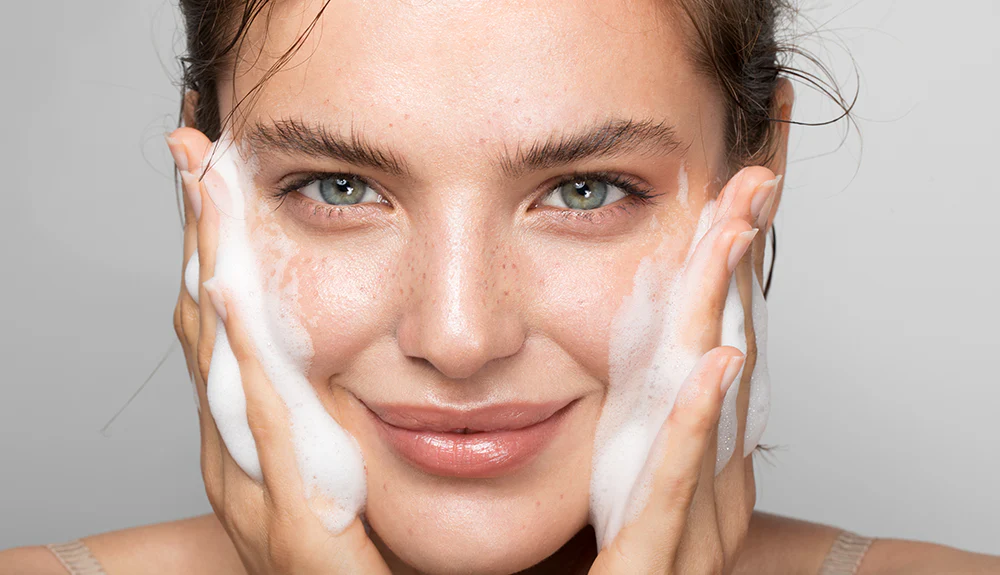In today’s fast-paced world, the beauty industry has placed a heavy emphasis on skincare. With so many products available, from cleansers to toners to serums, it’s easy to feel overwhelmed. However, a well-structured skincare routine can not only improve your skin’s appearance but also provide a sense of relaxation and self-care. The key to a skincare routine that works is personalization, consistency, and understanding your skin’s unique needs. In this article, we will explore how to build a skincare routine that suits your skin type, concerns, and lifestyle.
1. Understanding Your Skin Type
The first step in building an effective skincare routine is understanding your skin type. The wrong products can lead to irritation, breakouts, or dryness, while the right ones can enhance your skin’s natural glow and texture. There are five main skin types: oily, dry, combination, sensitive, and normal.
- Oily Skin: Characterized by excess sebum production, oily skin often has a shiny appearance, particularly in the T-zone (forehead, nose, and chin). People with oily skin may be more prone to clogged pores and acne.
- Dry Skin: Dry skin may feel tight, flaky, or rough, with visible dry patches. It can often feel uncomfortable and look dull.
- Combination Skin: A mix of both oily and dry areas, with the T-zone typically being oily and the rest of the face dry or normal.
- Sensitive Skin: Sensitive skin is easily irritated by products or environmental factors. It may experience redness, itching, burning sensations, or dryness.
- Normal Skin: Normal skin is balanced, neither too oily nor too dry, with no significant irritation or breakouts.
Once you know your skin type, you can choose the appropriate products to ensure your skincare routine works for you.
2. The Basic Skincare Routine
A basic skincare routine should consist of four key steps: cleansing, toning, moisturizing, and protecting. While there are additional products like exfoliators and serums that can be added, these four are the foundation of any effective skincare regimen.
Cleansing
Cleansing is the first and most essential step in any skincare routine. It removes dirt, excess oil, makeup, and other impurities that accumulate on your skin throughout the day. When selecting a cleanser, make sure it matches your skin type:
- For Oily Skin: Opt for a foaming or gel-based cleanser that helps control oil production.
- For Dry Skin: Choose a hydrating, cream-based cleanser that doesn’t strip moisture from your skin.
- For Sensitive Skin: Go for a fragrance-free, gentle, and non-foaming cleanser to avoid irritation.
- For Combination Skin: Look for a gentle, non-drying cleanser that works well for both oily and dry areas.
Cleansing should be done twice a day, once in the morning and once at night before bed.
Toning
After cleansing, toning is the next step. A toner helps balance the skin’s pH levels, remove any remaining impurities, and tighten the pores. Depending on your skin type, you may choose different types of toners:
- For Oily Skin: Look for toners that contain ingredients like witch hazel, salicylic acid, or tea tree oil to control oil and fight acne.
- For Dry Skin: Hydrating toners containing ingredients like glycerin, aloe vera, or rose water are ideal for replenishing moisture.
- For Sensitive Skin: Choose alcohol-free and fragrance-free toners to avoid irritation.
Moisturizing
Moisturizing is an essential step for all skin types, even oily skin. While it may seem counterintuitive, moisturizing helps maintain the skin’s hydration and prevents it from producing excess oil. The key is to choose the right moisturizer for your skin type:
- For Oily Skin: Lightweight, oil-free, or gel-based moisturizers are best for keeping the skin hydrated without feeling greasy.
- For Dry Skin: Rich, creamy moisturizers with ingredients like hyaluronic acid, ceramides, and shea butter are excellent for restoring moisture.
- For Sensitive Skin: Look for soothing ingredients like chamomile or calendula in your moisturizer to reduce redness and irritation.
Protecting (Sunscreen)
Sunscreen is arguably the most important step in any skincare routine. UV rays from the sun can cause premature aging, dark spots, and increase the risk of skin cancer. For effective sun protection, use a broad-spectrum sunscreen with an SPF of 30 or higher, even on cloudy days. It’s important to apply sunscreen every morning as the final step in your routine. Reapply every two hours if you’re spending time outdoors.
- For Oily Skin: Choose a lightweight, non-comedogenic sunscreen that won’t clog pores.
- For Dry Skin: Opt for moisturizing sunscreens that also hydrate the skin.
- For Sensitive Skin: Look for physical sunscreens with zinc oxide or titanium dioxide, as they are less likely to irritate sensitive skin.
3. Incorporating Additional Steps
Once you have a basic routine, you can consider adding additional products based on your skin’s specific needs. Some of these products include:
Exfoliants
Exfoliation removes dead skin cells from the surface of your skin, allowing for a brighter complexion and better absorption of your skincare products. However, exfoliating too frequently or using harsh products can damage the skin.
- For Oily Skin: Chemical exfoliants with salicylic acid are great for controlling oil and preventing breakouts.
- For Dry Skin: Gentle exfoliants like lactic acid or enzyme-based exfoliants are best for sloughing off dead skin without causing dryness.
- For Sensitive Skin: Opt for physical exfoliants with fine grains or choose mild chemical exfoliants like glycolic acid.
Exfoliate 1-3 times a week, depending on your skin type.
Serums and Treatments
Serums are concentrated formulas that target specific skin concerns such as acne, dark spots, wrinkles, or pigmentation. They usually contain active ingredients like vitamin C, retinol, hyaluronic acid, or niacinamide. Choose serums based on your skin’s needs:
- For Oily Skin: A vitamin C serum can brighten the complexion, while a niacinamide serum helps control oil production and minimize pores.
- For Dry Skin: Hyaluronic acid or hydrating serums are excellent for boosting moisture.
- For Sensitive Skin: Look for calming ingredients like chamomile or aloe vera.
Face Masks
Face masks can be a fun and effective way to give your skin an extra boost. Whether they are hydrating, brightening, or detoxifying, masks can complement your skincare routine. Use them once a week or as needed.
- For Oily Skin: Clay or charcoal masks are great for drawing out impurities and controlling oil.
- For Dry Skin: Hydrating masks with ingredients like honey or avocado provide deep moisture.
- For Sensitive Skin: Choose soothing masks with ingredients like aloe vera or oatmeal.
4. Consistency is Key
A successful skincare routine relies on consistency. Results won’t be immediate, and it may take a few weeks for your skin to adjust to new products. Stick to your routine, but be patient and avoid the temptation to try too many new products at once. Overloading your skin with too many active ingredients can lead to irritation and breakouts.
5. Adjust Your Routine Based on Seasons and Changes in Your Skin
As the seasons change, so do your skincare needs. For example, in winter, the skin tends to be drier, so you may need to switch to a more hydrating cleanser or moisturizer. In the summer, you might need to focus more on oil control and sun protection.
Additionally, lifestyle changes such as stress, diet, or hormonal shifts can affect your skin. Be mindful of these changes and adjust your routine accordingly.
6. FAQs
1. How often should I cleanse my face? Cleansing should be done twice daily—once in the morning to remove overnight buildup and once at night to wash away makeup, dirt, and impurities.
2. Can I skip toning in my skincare routine? Toning is optional but beneficial. It helps balance your skin’s pH and prepares it to absorb other products. If you have sensitive skin, you can skip toning or opt for a gentle toner.
3. Should I use both a moisturizer and sunscreen? Yes! Moisturizer helps keep your skin hydrated, while sunscreen protects your skin from harmful UV rays. Always apply sunscreen after moisturizing.
4. How do I know which serum is best for my skin? Choose a serum based on your skin’s concerns. For dark spots, try vitamin C. For dryness, opt for a hyaluronic acid serum. For acne, look for a serum with salicylic acid.
5. Can I use the same skincare routine every day? Yes, but remember to adjust it according to your skin’s needs. If you’re using active ingredients, avoid overuse to prevent irritation.
6. How do I exfoliate without irritating my skin? Use a gentle exfoliant and avoid over-exfoliating. Start with once a week and gradually increase to 2-3 times a week depending on your skin’s tolerance.
7. Should I change my skincare routine as I age? Yes, as you age, your skin may require products that address fine lines, wrinkles, and loss of elasticity. Ingredients like retinol, peptides, and hyaluronic acid can be beneficial.
Conclusion
Building a skincare routine that works requires understanding your skin’s unique needs, selecting the right products, and maintaining consistency. Start with the basics: cleansing, toning, moisturizing, and sun protection. Once you have these essentials in place, you can add targeted treatments such as exfoliants and serums. Be patient and adjust your routine as needed to match changes in your skin and lifestyle. Ultimately, a personalized skincare routine will help you achieve healthy, glowing skin and improve your confidence.
Key Takeaways
- Understand your skin type before choosing products.
- A basic skincare routine should include cleansing, toning, moisturizing, and sun protection.
- Additional products like serums, exfoliants, and masks can enhance your routine.
- Consistency is essential—results take time.
- Adapt your routine to seasonal changes and lifestyle factors for optimal results.

